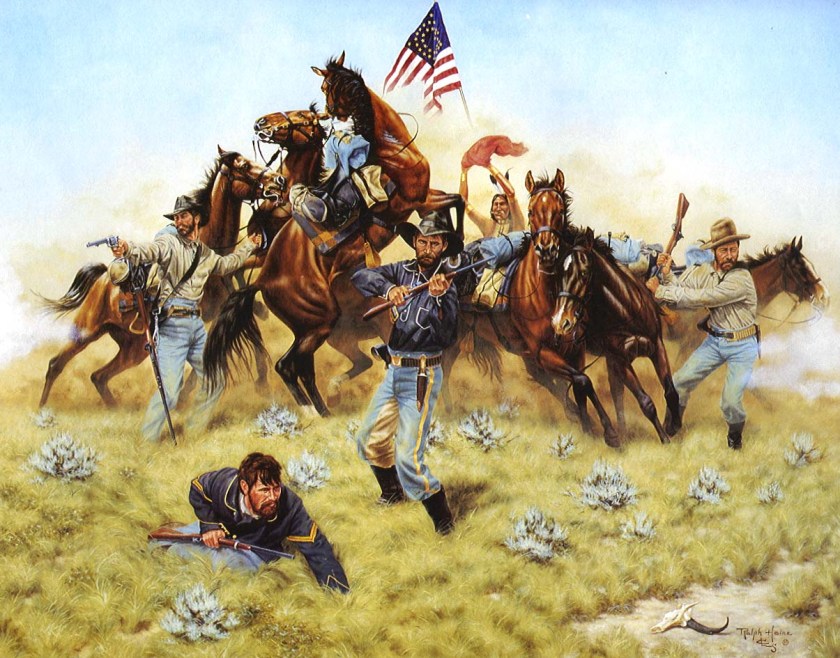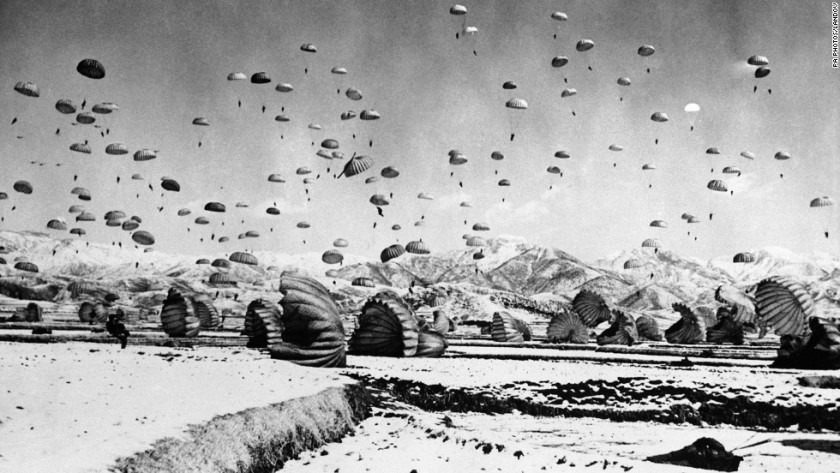It’s Sunday! Did you know…
* 1968 – Pierre Trudeau wins a majority in the 28th federal general election. (Trudeau, who was a relative unknown until he was appointed to the cabinet by Prime Minister Lester B. Pearson, had won a surprise victory over Paul Joseph James Martin, Paul Hellyer and Robert Winters in the party’s leadership election earlier in 1968. The charismatic, intellectual, handsome, single, and fully bilingual Trudeau soon captured the hearts and minds of the nation, and the period leading up to the election saw such intense feelings for him that it was dubbed “Trudeaumania.” At public appearances, he was confronted by screaming girls, something never before seen in Canadian politics.
The Liberal campaign was dominated by Trudeau’s personality. Liberal campaign ads featured pictures of Trudeau inviting Canadians to “Come work with me”, and encouraged them to “Vote for New Leadership for All of Canada”. The substance of the campaign was based on the creation of a “just society”, with a proposed expansion of social programs.
This was the first Canadian federal election to hold a leaders debate, on June 9, 1968. The debate included Trudeau, Stanfield, Douglas, and in the latter part Réal Caouette, with Caouette speaking French and Trudeau alternating between the languages. The assassination of Robert F. Kennedy three days before cast a pall over the proceedings, and the stilted format was generally seen as boring and inconclusive.
The results of the election were sealed when on the night before the election a riot broke out at the St. Jean Baptiste Day parade in Montreal. Protesting the prime minister’s attendance at the parade, supporters of Quebec independence yelled Trudeau au poteau [Trudeau to the gallows] and threw bottles and rocks. Trudeau, whose lack of military service during World War II had led some to question his courage, firmly stood his ground and did not flee from the violence despite the wishes of his security escort. Images of Trudeau standing fast to the thrown bottles of the rioters were broadcast across the country and swung the election even further in the Liberals’ favor as many English-speaking Canadians believed that he would be the right leader to fight the threat of Quebec separatism.)

* 1678 Venetian Elena Cornaro Piscopia is the 1st woman to receive a university doctoral degree or PhD. (Elena Lucrezia Cornaro Piscopia was born into a noble Venetian family on June 5, 1646 in Venice, Italy. Her father, Giovanni Baptista Cornaro, was the Procurator of San Marco and a highly esteemed Venetian. Elena’s mother, Zanetta Giovanna Boni, was not a member of the privileged upper class prior to her marriage. Elena’s father spent his life establishing the Cornaro name, a name which is to be remembered forever because of his eldest daughter’s intellect.
Beginning at age seven, Elena Piscopia received tutoring in the classical languages of Latin and Greek, as well as grammar and music. In addition to speaking both Latin and Greek fluently, Elena mastered Hebrew, Spanish, French, and Arabic. Her command of languages brought the title Oraculum Septilingue. Elena also exhibited marvelous reasoning powers. She was a student of the sciences as well as of languages, and she studied mathematics and astronomy in addition to philosophy and theology. Elena’s greatest love was for philosophy and theology. In 1672 Elena’s father sent her to the distinguished University of Padua to continue her studies.
Elena Piscopia did not seek degrees from the University of Padua; she simply wanted to continue her learning. However, Giovanni Cornaro insisted that the world recognize his daughter’s incredible knowledge. Thus, at his insistence, Elena applied for a Doctorate of Theology degree from the University of Padua. Her application met with resistance. Officials in the Roman Catholic Church refused to confer the title of Doctor of Theology upon a woman. Elena applied, again, at her father’s insistence. This time the Church compromised and allowed Elena Piscopia to apply for a Doctorate of Philosophy instead.
Elena Piscopia’s Examination for the Doctor of Philosophy degree was to be held in the University Hall of the University of Padua, but due to the multitude of spectators, it was transferred to the Cathedral of the Blessed Virgin, Padua. Throughout her examination, Elena’s brilliant answers amazed and awed her examiners, who determined that her vast knowledge surpassed the Doctorate of Philosophy. On June 25, 1678, Elena Lucrezia Cornaro Piscopia received the Doctorate of Philosophy degree from the University of Padua. At age thirty-two she was the first woman in the world to receive a doctorate degree. In addition to the doctorate degree, Elena Piscopia received the Doctor’s Ring, the Teacher’s Ermine Cape, and the Poet’s Laurel Crown.

* 1876 Battle of Little Bighorn. (On this day in 1876, Native American forces led by Chiefs Crazy Horse and Sitting Bull defeat the U.S. Army troops of Lieutenant Colonel George Armstrong Custer in a bloody battle near southern Montana’s Little Bighorn River.
Crazy Horse and Sitting Bull, leaders of the Sioux tribe on the Great Plains, strongly resisted the mid-19th-century efforts of the U.S. government to confine their people to reservations. In 1875, after gold was discovered in South Dakota’s Black Hills, the U.S. Army ignored previous treaty agreements and invaded the region. This betrayal led many Sioux and Cheyenne tribesmen to leave their reservations and join Sitting Bull and Crazy Horse in Montana. By the late spring of 1876, more than 10,000 Native Americans had gathered in a camp along the Little Bighorn River–which they called the Greasy Grass–in defiance of a U.S. War Department order to return to their reservations or risk being attacked.
In mid-June, three columns of U.S. soldiers lined up against the camp and prepared to march. A force of 1,200 Native Americans turned back the first column on June 17. Five days later, General Alfred Terry ordered Custer’s 7th Cavalry to scout ahead for enemy troops. On the morning of June 25, Custer drew near the camp and decided to press on ahead rather than wait for reinforcements.
At mid-day, Custer’s 600 men entered the Little Bighorn Valley. Among the Native Americans, word quickly spread of the impending attack. The older Sitting Bull rallied the warriors and saw to the safety of the women and children, while Crazy Horse set off with a large force to meet the attackers head on. Despite Custer’s desperate attempts to regroup his men, they were quickly overwhelmed. Custer and some 200 men in his battalion were attacked by as many as 3,000 Native Americans; within an hour, Custer and every last one of his soldiers was dead.
The Battle of Little Bighorn–also called Custer’s Last Stand–marked the most decisive Native American victory and the worst U.S. Army defeat in the long Plains Indian War. The gruesome fate of Custer and his men outraged many white Americans and confirmed their image of the Indians as wild and bloodthirsty. Meanwhile, the U.S. government increased its efforts to subdue the tribes. Within five years, almost all of the Sioux and Cheyenne would be confined to reservations.)

* 1950 Korean War begins. (Armed forces from communist North Korea smash into South Korea, setting off the Korean War. The United States, acting under the auspices of the United Nations, quickly sprang to the defense of South Korea and fought a bloody and frustrating war for the next three years.
Korea, a former Japanese possession, had been divided into zones of occupation following World War II. U.S. forces accepted the surrender of Japanese forces in southern Korea, while Soviet forces did the same in northern Korea. Like in Germany, however, the “temporary” division soon became permanent. The Soviets assisted in the establishment of a communist regime in North Korea, while the United States became the main source of financial and military support for South Korea.
On June 25, 1950, North Korean forces surprised the South Korean army (and the small U.S. force stationed in the country) and quickly headed toward the capital city of Seoul. The United States responded by pushing a resolution through the U.N.’s Security Council calling for military assistance to South Korea. (Russia was not present to veto the action as it was boycotting the Security Council at the time.) With this resolution in hand, President Harry S. Truman rapidly dispatched U.S. land, air, and sea forces to Korea to engage in what he termed a “police action.” The American intervention turned the tide, and U.S. and South Korean forces marched into North Korea. This action, however, prompted the massive intervention of communist Chinese forces in late 1950. The war in Korea subsequently bogged down into a bloody stalemate. In 1953, the United States and North Korea signed a cease-fire that ended the conflict. The cease-fire agreement also resulted in the continued division of North and South Korea at just about the same geographical point as before the conflict.
The Korean War was the first “hot” war of the Cold War. Over 55,000 American troops were killed in the conflict. Korea was the first “limited war,” one in which the U.S. aim was not the complete and total defeat of the enemy, but rather the “limited” goal of protecting South Korea. For the U.S. government, such an approach was the only rational option in order to avoid a third world war and to keep from stretching finite American resources too thinly around the globe. It proved to be a frustrating experience for the American people, who were used to the kind of total victory that had been achieved in World War II. The public found the concept of limited war difficult to understand or support and the Korean War never really gained popular support.)

* 2009 “King of Pop” Michael Jackson dies at age 50. (On this day in 2009, Michael Jackson, one of the most commercially successful entertainers in history, dies at the age of 50 at his home in Los Angeles, California, after suffering from cardiac arrest caused by a fatal combination of drugs given to him by his personal doctor.
Michael Joseph Jackson was born on August 29, 1958, in Gary, Indiana, the seventh of Katherine and Joe Jackson’s nine children. At the age of 5, Jackson began performing with his older brothers in a music group coached by their steelworker father. In 1968, Motown Records signed the group, which became known as the Jackson 5, and Michael Jackson, a natural showman, emerged as the lead singer and star. The Jackson 5’s first album, released in 1969, featured the hit “I Want You Back,” and the group’s brand of pop-soul-R&B music made them an immediate success. Their musical popularity even led to their starring in their own TV cartoon series in the early 1970s.
Jackson released his first solo album, “Got to Be There,” in 1972, while continuing to sing with his brothers. Six years later, in 1978, he made his big-screen debut as the Scarecrow in “The Wiz,” an adaptation of the Broadway musical of the same name. Directed by Quincy Jones, the film starred an all-black cast that included singer Diana Ross as Dorothy. Jones collaborated with Jackson on his 1979 album “Off the Wall,” which sold some 7 million copies worldwide. The pair teamed up again for Jackson’s now-iconic 1982 album, “Thriller,” which went on to sell 50 million copies around the globe, making it the best-selling studio album of all time. “Thriller” is credited with jump-starting the era of music videos and playing a key role in the rise of then-fledging cable TV network MTV, which launched in 1981.
In 1983, Jackson created a massive sensation on a live Motown anniversary TV special when he performed his now-signature Moonwalk dance step while wearing a black fedora and a single white glove covered with rhinestones. According to The Los Angeles Times critic Robert Hillburn, the performance served as Jackson’s “unofficial coronation as the King of Pop. Within months, he changed the way people would hear and see pop music, unleashing an influence that rivaled that of Elvis Presley and the Beatles.”
Jackson’s next solo effort, “Bad,” debuted in 1987. It sold 8 million copies and featured a music video from acclaimed movie director Martin Scorsese. By this time, however, Jackson had paid a high price for his massive success. According to The Los Angeles Times: “He became so accustomed to bodyguards and assistants that he once admitted that he trembled if he had to open his own front door.”
By the 1990s, Jackson’s life was near-constant tabloid fodder. In 1993, he was accused of molesting a 13-year-old boy who had been a sleepover guest at his home. Jackson denied the allegations and the criminal investigation was dropped; however, the singer later settled a civil lawsuit with the boy’s family for a reported $20 million. In 2003, Jackson was accused of molesting another boy. Following a highly publicized trial in 2005, he was acquitted of all charges. During these years, Jackson also faced intense media scrutiny over his radically altered physical appearance, which included an ever-lighter complexion (which he attributed to a skin condition) and multiple plastic surgeries. Although Jackson himself was mostly close-mouthed on the topic, media sources alleged that Jackson developed an obsession with cosmetic surgery, in part, following an accident he suffered in January 1984 while shooting a Pepsi commercial. During filming, a pyrotechnics mishap set the singer’s hair on fire, and he suffered burns on his head and face that required reconstructive surgery. In the aftermath of the surgery, Jackson reportedly suffered from an addiction to prescription painkillers.
Jackson also made headlines with his brief marriage (1994-1994) to Lisa Marie Presley, the daughter of singer Elvis Presley. From 1996 to 1999, he was wed to Debbie Rowe, the former assistant of his dermatologist and the mother of two of his three children. (Jackson’s youngest child, a boy, was reportedly born via a surrogate.)
On June 25, 2009, Jackson, who after a lengthy time away from the public spotlight was preparing for a series of summer concerts in London, was discovered unconscious in his Los Angeles mansion. The Los Angeles coroner’s officer later ruled the pop star’s death a homicide after lethal levels of the powerful sedative propofol, as well other drugs, were found in his system. Jackson’s personal physician, who was at the singer’s home when he died, had been giving him propofol as a sleep aid for a period of weeks.
On July 7, 2009, more than 20,000 fans attended a public memorial for Jackson at the Staples Center in Los Angeles. Over 30 million viewers tuned in watch the event on cable TV, while millions more viewed it online.)

Today’s Sources:
* Canadian History Timeline – Canada’s Historical Chronology http://canadachannel.ca/todayincanadianhistory/index.php
* On This Day – History, Film, Music and Sport http://www.onthisday.com/
* This Day In History – What Happened Today http://www.history.com/this-day-in-history/
* Wikipedia – The Free Encyclopedia https://en.wikipedia.org/wiki/Canadian_federal_election,_1968
* Biographies of Women Mathematicians https://www.agnesscott.edu/lriddle/women/piscopia.htm


Aw, the good old days when Trudeau (senior) was our PM. 🙂
LikeLiked by 1 person
Yes, Debbie – they were good days. I remember the regret I felt when he died because I had harboured a wish to sit with him over a coffee and talk about many things. Oh well. Thanks for your comment!
LikeLiked by 1 person
And our dollar was stronger than the US, lol. 🙂 Good times!
LikeLiked by 1 person
Oh, happy days indeed with a stronger dollar! I hope Justin stays in power for a long time – until his son or daughter can take over.
LikeLiked by 1 person
LOL 🙂
LikeLiked by 1 person
🤗😇
LikeLiked by 1 person
The story about Elena Piscopia earning a degree in that day and age is absolutely incredible, John. I was very sad when Michael Jackson died as he was a real icon when I was at school.
LikeLiked by 1 person
I thought Elena’s story was amazing as well! Michael Jackson’s untimely death was a huge loss for us all – his talent and creativity seemed limitless. Thanks for sharing your thoughts, Robbie!
LikeLiked by 1 person
Another great post, John. I was particularly drawn to the Battle of Little Bighorn, realizing once again the role of violence in our lives. Hope your Sunday is perfect…and thank you for sharing your wisdom.
LikeLiked by 1 person
Yes, I was drawn to that story too, Gwen. Did you see the movie Little Big Man with Dustin Hoffman and Chief Dan George (Canadian chief)? It was the first movie to tell the story from the Natives’ point of view. Thanks for your insight today.
LikeLiked by 1 person
A number of separate events but excellent historical reference. Enjoyed the recap of the Trudeau’s election.
LikeLiked by 1 person
Thanks, John – Pierre Trudeau is my #1 favorite Prime Minister. Looks like we were commenting on each other’s posts at the same time. By the way, Anne got a big kick out of the “writer or homeless guy” in Edinburgh!
LikeLiked by 1 person
Thanks. Made me chuckle too.
LikeLiked by 1 person